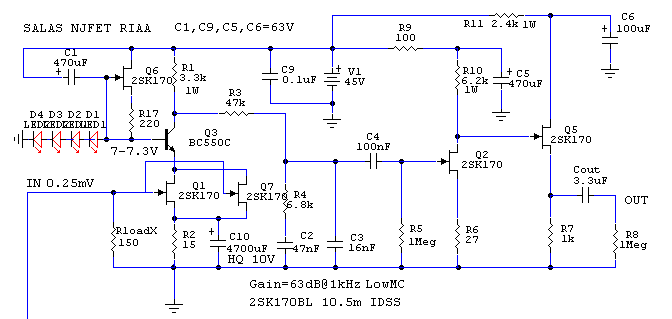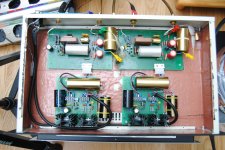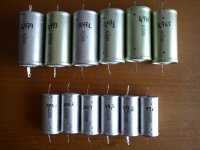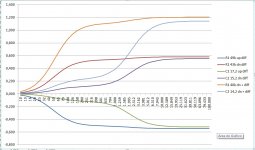I also found that bypassing the output caps can make a big difference.
I would not bypass expensive caps like the good Mundorfs or Duellunds but all other MKP deserve this attention.
After long experiments with small valued Auricaps, FT-3, polystirenes and SM I found that the obligatos like small obligatos.
In this case 4u7 // .047u did the magic.
In the shunts, the low cost Audyn is bypassed by a small 10pF SM. This opens up the sound producing much more explicit highs and tighter well defined lows.
These Audyns are very close to the Mundorfs MKP and respond as well to the bypassing act.
I would not bypass expensive caps like the good Mundorfs or Duellunds but all other MKP deserve this attention.
After long experiments with small valued Auricaps, FT-3, polystirenes and SM I found that the obligatos like small obligatos.
In this case 4u7 // .047u did the magic.
In the shunts, the low cost Audyn is bypassed by a small 10pF SM. This opens up the sound producing much more explicit highs and tighter well defined lows.
These Audyns are very close to the Mundorfs MKP and respond as well to the bypassing act.
Attachments
Now I'm testing with 15.33nF RIAA cap, first impressions is the sound is more equilibrated over all audible bandwith.
What cap are you using ?
I found that a full SM combination brings more detail and snap but needs adjustments to get the high bass up a notch.
Using Tin Foil polystyrenes produces a bigger fuller, nicer presence but somehow lacks the high freq bite.
As I wanted to understand the effect of reducing the 15.72nF to 15.33nF and also the effect of fiddling with the 47kr resistor. I made the following simulations.
It looks like such a simulation cannot be fully accurate, since, at least, it doesn't take into account stray capacitance in the circuit. Which is one more reason for listening tests being indispensable.
This is not intended to be accurate.
It represents the possible deviations (errors) from perfect riaa setup.
I compared the results against proven Salas setup.
In this case (48dB) C2 is 15.33nF and R1 is 47kr.
I just wanted to show what error each component might introduce and how.
I am not suggesting anyone should deviate from Salas schematic but I agree that sometimes it is important to tune these components by ear and this graph gives a visual idea of what to expect.
Lowering the 15n cap introduces a rise in responce from 1000Hz onwards.
(A very small change "10pF" can be clearly heard)
Lowering the 47kr produces much dramatic effects in the power band.
It represents the possible deviations (errors) from perfect riaa setup.
I compared the results against proven Salas setup.
In this case (48dB) C2 is 15.33nF and R1 is 47kr.
I just wanted to show what error each component might introduce and how.
I am not suggesting anyone should deviate from Salas schematic but I agree that sometimes it is important to tune these components by ear and this graph gives a visual idea of what to expect.
Lowering the 15n cap introduces a rise in responce from 1000Hz onwards.
(A very small change "10pF" can be clearly heard)
Lowering the 47kr produces much dramatic effects in the power band.
Last edited:
Hi Merlin
For C3 I believe you are talking about the 15.33nF cap right ?
Acording to Salas revised pdf, for 43~48dB you should use 15.33nF
For higher gain, you can use 15.10nF.
I am using those values and tuned the results on the shunts vref and output caps... but I am not using special caps there so the results are different and depend on the rest of the components choices.
The most important components are R4 and C2 that form the 500.5Hz turn point.
I can run your setup in my simulator but I need to know all the values of the resistors and caps you are using on the passive riaa filter.
For C3 I believe you are talking about the 15.33nF cap right ?
Acording to Salas revised pdf, for 43~48dB you should use 15.33nF
For higher gain, you can use 15.10nF.
I am using those values and tuned the results on the shunts vref and output caps... but I am not using special caps there so the results are different and depend on the rest of the components choices.
The most important components are R4 and C2 that form the 500.5Hz turn point.
I can run your setup in my simulator but I need to know all the values of the resistors and caps you are using on the passive riaa filter.
Hi Merlin
For C3 I believe you are talking about the 15.33nF cap right ?
Acording to Salas revised pdf, for 43~48dB you should use 15.33nF
For higher gain, you can use 15.10nF.
I am using those values and tuned the results on the shunts vref and output caps... but I am not using special caps there so the results are different and depend on the rest of the components choices.
The most important components are R4 and C2 that form the 500.5Hz turn point.
I can run your setup in my simulator but I need to know all the values of the resistors and caps you are using on the passive riaa filter.
Yes, I'm refering to this schematic, I'm using the same values except R3 47K bypassed with 1Meg, I have exactly 47nF what happens if I increase or reduce the value? could you post the simulation?

- Home
- Source & Line
- Analogue Source
- Simplistic NJFET RIAA


